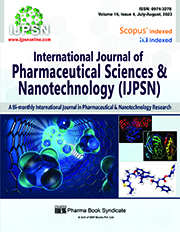Application of Nanotechnology in Malaria Research
DOI:
https://doi.org/10.37285/ijpsn.2023.16.4.1Abstract
Introduction
In many ways, malaria is giving a challenge to researchers globally, day by day. But, the potential of nanotechnology/nanomedicine to work at the nanoscale has allowed us to target receptors/molecules of the parasite directly at a nanoscale level as well as the impetus to develop devious nanostructures that could solve the problems which previously impeded the conventional pharmacological approaches from being successful. Over the four decades, the slow but steady integration of life-sciences disciplines and nanotechnology has started transforming the way to detect and diagnose for the betterment of health1. This idea was first presented in 1974 by Professor Norio Taniguchi2, and it received the least attention concerning malaria. However, drug resistance, social demerits, and environmental concerns made malaria the exterminator and notorious disease that is known to all. The mainstay of current anti-plasmodial medication is chemotherapy, which comes with toxic severe side effects. Resistance among the parasite spp. that leads to treatment failure, insufficient knowledge of the biology and pathology of a parasite, complexity of life-cycle, dispersed locations of Plasmodium spp., and the difficulty in developing new antimalarial drugs as this development process is time-consuming and an expensive, poses a significant challenge when researchers are trying to create new antimalarial medications3. Therefore, researchers are trying to deliver drugs without toxicity and improve efficacy4 by employing nanotechnological approaches. It enhances its solubility profile, modifies the pharmacokinetic characteristics of the drug, prevents drug deterioration, and supports a continuous release of the drug at the intended site.
Downloads
Metrics
Keywords:
Nanoparticles: Nanotechnology, Malaria ResearchDownloads
Published
How to Cite
Issue
Section
References
2. Taniguchi, Norio.,1974, On the Basic Concept of 'Nanotechnology', Proc. Intl. Conf. Prod. Eng. Tokyo, Part II, Japan Soc. Precis. Eng.
3. Walter, N. S., Gorki, V., Chauhan, M., Dhingra, N., & Kaur, S. (2021). Sinigrin in combination with artesunate provides protection against lethal murine malaria via falcipain-3 inhibition and immune modulation. Int. Immunopharmacol, 101(Pt A), 108320.
4. Rizvi, S. A. A., & Saleh, A. M. (2018). Applications of nanoparticle systems in drug delivery technology. Saudi Pharm J: SPJ: the official publication of the Saudi Pharmaceutical Society, 26(1), 64–70.
5. Gedda, M. R., Madhukar, P., Vishwakarma, A. K., Verma, V., Kushwaha, A. K., Yadagiri, G., Mudavath, S. L., Singh, O. P., Srivastava, O. N., & Sundar, S. (2020). Evaluation of Safety and Antileishmanial Efficacy of Amine Functionalized Carbon-Based Composite Nanoparticle Appended with Amphotericin B: An in vitro and Preclinical Study. Front. Chem., 8, 510.
6. Rahman K, Khan SU, Fahad S, Chang MX, Abbas A, Khan WU, Rahman L, Haq ZU, Nabi G, Khan D. 2019. Nano-biotechnology: a new approach to treat and prevent malaria. Int J Nanomed 14: 1401-1410.
7. Alving C. R. (1986). Liposomes as drug carriers in leishmaniasis and malaria. Parasitology today (Personal ed.), 2(4), 101–107.
8. Isacchi, B., Bergonzi, M. C., Grazioso, M., Righeschi, C., Pietretti, A., Severini, C., & Bilia, A. R. (2012). Artemisinin and artemisinin plus curcumin liposomal formulations: enhanced antimalarial efficacy against Plasmodium berghei-infected mice. European journal of pharmaceutics and biopharmaceutics: official journal of Arbeitsgemeinschaft fur Pharmazeutische Verfahrenstechnik e.V, 80(3), 528–534.
9. Aditya, N. P., Chimote, G., Gunalan, K., Banerjee, R., Patankar, S., & Madhusudhan, B. (2012). Curcuminoids-loaded liposomes in combination with arteether protects against Plasmodium berghei infection in mice. Exp. parasitol, 131(3), 292–299.
10. Rajendran, V., Hasan, G.M., Kumar, N., Dutta, S., Garg, N., Ghosh, P.T., C., and P, 2016. Therapeutic efficacy of chloroquine in long circulating liposome formulations against chloroquine-resistant plasmodium. Eur. J. Biomed. Pharm. Sci. 3, 258–264.
11. Fang, C. L., Al-Suwayeh, S. A., & Fang, J. Y. (2013). Nanostructured lipid carriers (NLCs) for drug delivery and targeting. Recent pat on nanotechnol, 7(1), 41–55.
12. Gujjari, L., Kalani, H., Pindiprolu, S. K., Arakareddy, B. P., & Yadagiri, G. (2022). Current challenges and nanotechnology-based pharmaceutical strategies for the treatment and control of malaria. Parasite epidemiol control, 17, e00244.
13. Huang, W. C., Deng, B., Lin, C., Carter, K. A., Geng, J., Razi, A., He, X., Chitgupi, U., Federizon, J., Sun, B., Long, C. A., Ortega, J., Dutta, S., King, C. R., Miura, K., Lee, S. M., & Lovell, J. F. (2018). A malaria vaccine adjuvant based on recombinant antigen binding to liposomes. Nat nanotechnol, 13(12), 1174–1181.
14. Wilson, K. L., Pouniotis, D., Hanley, J., Xiang, S. D., Ma, C., Coppel, R. L., & Plebanski, M. (2019). A Synthetic Nanoparticle Based Vaccine Approach Targeting MSP4/5 Is Immunogenic and Induces Moderate Protection Against Murine Blood-Stage Malaria. Front immunol, 10, 331.
15. Desai N. (2012). Challenges in development of nanoparticle-based therapeutics. AAPS J, 14(2), 282–295.






